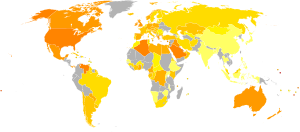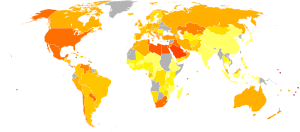| Part of a series on |
| Human body weight |
|---|



Obesity has been observed throughout human history. Many early depictions of the human form in art and sculpture appear obese.[2] However, it was not until the 20th century that obesity became common — so much so that, in 1997, the World Health Organization (WHO) formally recognized obesity as a global epidemic[3] and estimated that the worldwide prevalence of obesity has nearly tripled since 1975.[4] Obesity is defined as having a body mass index (BMI) greater than or equal to 30 kg/m2, and in June 2013 the American Medical Association classified it as a disease.[5]
In countries of the Organisation for Economic Co-operation and Development (OECD), one child out of five is overweight or obese.[6] Once considered a problem only of high-income countries, obesity rates are rising worldwide. In 2014, the mean BMI in 128 countries was above the threshold for overweight.[7] Globally, there are now more people who are obese than who are underweight, a trend observed in every region over the world except parts of sub-Saharan Africa and Asia.[8] In 2013, an estimated 2.1 billion adults were overweight, as compared with 857 million in 1980.[9] Of adults who are overweight, 31% are obese.[8] Increases in obesity have been seen most in urban settings.[10]
Since body fat can be measured in several ways, statistics on the epidemiology of obesity vary between sources. While BMI is the most basic and commonly used indicator of obesity, other measures include waist circumference, waist-to-hip ratio, skinfold thicknesses, and bioelectrical impedance.[11] The rate of obesity increases with age at least up to 50 or 60 years old.[12] Sex- and gender-based differences also influence the prevalence of obesity. Globally there are more obese women than men, but the numbers differ depending on how obesity is measured.[13][14]
- ^ a b "www.worldobesity.org" (PDF). Global prevalence of overweight and obesity. Archived from the original (PDF) on March 5, 2016. Retrieved Jan 8, 2016.
- ^ Haslam D (March 2007). "Obesity: a medical history". Obes Rev. 8 (Suppl 1): 31–6. doi:10.1111/j.1467-789X.2007.00314.x. PMID 17316298.
- ^ Caballero B (2007). "The global epidemic of obesity: An overview". Epidemiol Rev. 29: 1–5. doi:10.1093/epirev/mxm012. PMID 17569676.
- ^ "Obesity and overweight". World Health Organization.
- ^ "Proceedings of the 2013 Annual Meeting of the House of Delegates". American Medical Association. 5 September 2023.
- ^ "OBESITY Update 2014, Retrieved 25 June 2014" (PDF).
- ^ "Global status report on noncommunicable diseases 2014". World Health Organization. Archived from the original on January 20, 2015. Retrieved 10 April 2018. (Statistics start on page 200).
- ^ a b World Health Organization, Obesity and overweight. Fact sheet, updated June 2016. Geneva. Retrieved 22 Sept 2017.
- ^ Ng, M.; Fleming, T.; Robinson, M.; Thomson, B.; Graetz, N.; Margono, C.; Mullany, E. C.; Biryukov, S.; Abbafati, C.; Abera, S. F.; Abraham, J. P.; Abu-Rmeileh, N. M. E.; Achoki, T.; Albuhairan, F. S.; Alemu, Z. A.; Alfonso, R.; Ali, M. K.; Ali, R.; Guzman, N. A.; Ammar, W.; Anwari, P.; Banerjee, A.; Barquera, S.; Basu, S.; Bennett, D. A.; Bhutta, Z.; Blore, J.; Cabral, N.; Nonato, I. C.; et al. (29 May 2014). "Global, regional, and national prevalence of overweight and obesity in children and adults during 1980–2013: A systematic analysis for the Global Burden of Disease Study 2013". The Lancet. 384 (9945): 766–781. doi:10.1016/S0140-6736(14)60460-8. ISSN 0140-6736. PMC 4624264. PMID 24880830.
- ^ World Health Organization (2000). Technical report series 894: Obesity: Preventing and managing the global epidemic (PDF). Geneva: World Health Organization. ISBN 978-92-4-120894-9. Archived from the original (PDF) on May 26, 2006.
- ^ Harvard T.H. Chan School of Public Health, Obesity Prevention Source. Boston. Retrieved 22 Sept 2017.
- ^ Peter G. Kopelman; Ian D. Caterson; Michael J. Stock; William H. Dietz (2005). Clinical obesity in adults and children: In Adults and Children. Blackwell Publishing. p. 493. ISBN 978-1-4051-1672-5.
- ^ Robertson, Clare; Archibald, Daryll; Avenell, Alison; Douglas, Flora; Hoddinott, Pat; van Teijlingen, Edwin; Boyers, Dwayne; Stewart, Fiona; Boachie, Charles; Fioratou, Evie; Wilkins, David; Street, Tim; Carroll, Paula; Fowler, Colin (2014-05-01). "Systematic reviews of and integrated report on the quantitative, qualitative and economic evidence base for the management of obesity in men". Health Technology Assessment. 18 (35): v–vi, xxiii–xxix, 1–424. doi:10.3310/hta18350. ISSN 2046-4924. PMC 4781190. PMID 24857516.
- ^ "Managing obesity in men". NIHR Evidence. 2016-05-10. doi:10.3310/highlight-000844. Retrieved 2022-12-07.
© MMXXIII Rich X Search. We shall prevail. All rights reserved. Rich X Search
